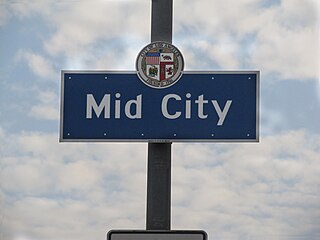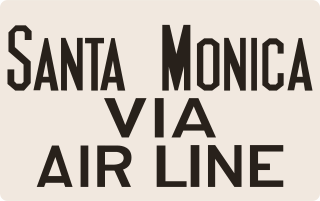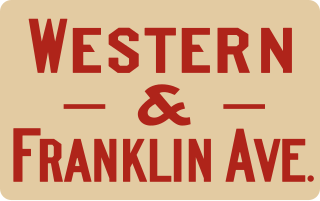
The Pacific Electric Railway Company, nicknamed the Red Cars, was a privately owned mass transit system in Southern California consisting of electrically powered streetcars, interurban cars, and buses and was the largest electric railway system in the world in the 1920s. Organized around the city centers of Los Angeles and San Bernardino, it connected cities in Los Angeles County, Orange County, San Bernardino County and Riverside County.

Moses Hazeltine Sherman was an American land developer who built the Phoenix Street Railway in Phoenix, Arizona and streetcar systems that would become the core of the Los Angeles Railway and part of the Pacific Electric Railway in Los Angeles, California, and owned and developed property in areas such as the westside of Los Angeles, the San Fernando Valley and Hollywood, California. He also served on the Los Angeles Water Board. He was also known as M. H. Sherman and General M. H. Sherman.

Mid City is a neighborhood in Central Los Angeles, California.

Santa Monica Boulevard is a major west–east thoroughfare in Los Angeles County. It runs from Ocean Avenue in Santa Monica near the Pacific Ocean to Sunset Boulevard at Sunset Junction in Los Angeles. It passes through Beverly Hills and West Hollywood. A portion of it is designated as California State Route 2.

San Vicente Boulevard is a major northwest-southeast thoroughfare located in the western portion of the metropolitan area of Los Angeles, CA.

Venice Boulevard is a major east–west thoroughfare in Los Angeles, running from the ocean in the Venice district, past the I-10 intersection, into downtown Los Angeles. It was originally known as West 16th Street under the Los Angeles numbered street system.

Glendale–Burbank is a defunct Pacific Electric railway line that was operational from 1902 to 1955 in Southern California, running from Downtown Los Angeles to Burbank via Glendale. Short lines terminated Downtown and in North Glendale, including the popular Edendale Local.

The Santa Monica Air Line was an interurban railroad operated by the Pacific Electric between Santa Monica and downtown Los Angeles. Electric passenger service operated over the line between 1908 and 1953. After abandonment as a freight railroad, most of the route was converted to light rail for use by the Metro E Line.
The Westgate Line was a suburban route operated by the Pacific Electric Railway from 1911 to 1940. This line was one of four lines connecting Downtown Los Angeles and Santa Monica that did not run through Hollywood. The line is notable for taking a circuitous route towards its end, along San Vicente Boulevard, mainly because it was built to encourage construction of new homes near Pacific Palisades.
The South Hollywood–Sherman Line was a suburban route of the Pacific Electric Railway. The line ran between Downtown Los Angeles and the suburb of Sherman. The line was named after Moses Sherman, who built the line and the Sherman street car yard on the line in West LA. The large 5.56-acre (2.25 ha) rail facility was on Santa Monica Boulevard just west of La Cienega Boulevard. The yard had a steam power house, a car barn and a shop building.

The Hollywood Line was a local streetcar line of the Pacific Electric Railway. It primarily operated between Downtown Los Angeles and Hollywood, with some trips as far away as Beverly Hills and West Los Angeles. It was the company's busiest route prior to the opening of the Hollywood Subway. Designated as route 32, the line operated from 1909 until 1953.

The Hawthorne–El Segundo Line was an interurban railway route of the Pacific Electric Railway. It was built to transport oil from the Standard Oil Refinery in El Segundo and also saw passenger service.

The Long Beach Line was a major interurban railway operated by the Pacific Electric Railway between Los Angeles and Long Beach, California via Florence, Watts, and Compton. Service began in 1902 and lasted until 1961, the last line of the system to be replaced by buses. However, the Southern Pacific Transportation Company continued to operate freight on the tracks, as the Union Pacific Railroad still does between Amoco and Dominguez Junction, and in 1990 the Southern California Rapid Transit District opened the Blue Line light rail along the same right-of-way.

The Venice Short Line was a Pacific Electric interurban railway line in Los Angeles which traveled from downtown Los Angeles to Venice, Ocean Park, and Santa Monica via Venice Boulevard.

The Los Angeles Pacific Railroad (1896−1911) (LAP) was an electric public transit and freight railway system in Los Angeles County, California. At its peak it had 230 miles (370 km) of track extending from Downtown Los Angeles to the Westside, Santa Monica, and the South Bay towns along Santa Monica Bay.
Pico/Rimpau is an area of Mid-City, Los Angeles, at the junction of Pico Boulevard, Rimpau Street, San Vicente Boulevard, Venice Boulevard, Vineyard Boulevard and West Boulevard. This area is the location of several key former and current transportation hubs and retail shopping centers for the Los Angeles area.

The Western and Franklin Avenue Line was a Pacific Electric streetcar line which traveled from Los Angeles to Hollywood. It operated from 11th and Hill Streets via Hill, Sunset, Santa Monica Boulevard, Western Avenue, Franklin Avenue, Argyle Avenue, Yucca Street, and Vine Street to end at Hollywood and Vine Boulevards. It operated from 1908 to 1940. The Brush Canyon Line branched from this line at Bronson.

The Venice–Inglewood Line is a former Pacific Electric interurban railway line in Los Angeles County, California. Service was very sparse, providing a suburban service between Venice and Inglewood.

The Redondo Beach via Playa del Rey was an interurban railway route of the Pacific Electric. It operated between the Hill Street Terminal and Cliffton, south of Redondo Beach, through the company's Western Division.
The Venice Boulevard Line was a local streetcar line of the Pacific Electric. It operated between Downtown Los Angeles and Vineyard Junction, where riders could transfer to interurban cars. Nearly all Venice Short Line cars did not accept local passengers, leaving this as the primary streetcar service along its namesake boulevard.




















